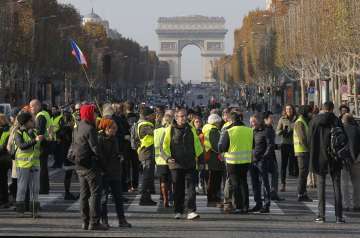France: Protests over rising fuel taxes tun violent, one killed, 227 injured
French Interior Ministry officials counted nearly 283,000 protesters, mostly peaceful, throughout the day at more than 2,000 sites, some setting bonfires or flying balloons.

One protester was killed and 227 other people were injured — eight seriously — at roadblocks set up around villages, towns and cities across France on Saturday as citizens angry with rising fuel taxes rose up in a grassroots movement, posing a new challenge to beleaguered President Emmanuel Macron.
Police officers lobbed tear gas canisters at demonstrators on the famed Champs-Elysees Avenue in Paris as groups of “yellow jackets,” as the protesters called themselves, tried to make their way to the presidential Elysee Palace. Later, hundreds of protesters entered the bottom of the street dotted with luxury shops where the palace is located — and where Macron lives — before being pushed back by security forces with shields.
In a similar scenario, police cleared out the huge traffic circle around the Arc de Triomphe, paralyzed for hours by protesters.
French Interior Ministry officials counted nearly 283,000 protesters, mostly peaceful, throughout the day at more than 2,000 sites, some setting bonfires or flying balloons.
However, some demonstrations turned violent. In Troyes, southeast of Paris, about 100 people invaded the prefecture, the local representation of the state, damaging the inside, Interior Ministry officials said. In Quimper, in Brittany, security forces used water cannon to disperse hostile protesters.
The protester who died, a 63-year-old woman, was killed when a driver caught in the blockade accelerated in a panic at Pont-de-Beauvoisin, near Chambery, in eastern France, according to Louis Laugier, the prefect, or top state official, in the Savoie region. A confrontation with protesters “got heated up for no reason” and the driver accelerated her minivan after “people started rattling her car,” a protester who witnessed the incident told BFMTV, identifying himself only as Philippe. He said the woman told them she was taking her daughter to a doctor.
An investigation into the death was opened.
Eight of the 227 people injured were in serious condition, ministry officials said at an evening briefing, without providing details. A police officer and a firefighter who intervened when protesters attacked a closed service station were among the eight.
A total of 117 people were arrested with 73 of them held for questioning.
The protesters had pledged to target tollbooths, roundabouts and other strategic traffic sites. They called themselves “yellow jackets” because most were wearing the fluorescent yellow vests that must be kept in vehicles of all French drivers in case of car troubles.
The daughter of the woman killed called for calm as she protested in Cavaillon, in southern France.
“I really want people not to let themselves become submerged by anger,” Alexandrine Mazet told RTL radio. “The yellow jackets must understand this is a peaceful movement,” she said. The young woman appeared later on BFMTV still wearing her yellow vest.
The nationwide protest was unusual because it arose from within the citizenry, backed neither by unions nor politicians, although some took part in a clear bid for supporters. It was unclear whether the upstart movement, without a leader, would survive, and what problems it might pose for Macron.
The grassroots nature of the protests, which drew supporters angry over an array of issues, made it a political hot potato for Macron’s government. Security officials treaded lightly, ordering police to use dialogue rather than force but to stop protesters from completely blocking major routes or endangering lives or property. About 30 canisters of tear gas were fired to disperse protesters at the entrance of the Mont Blanc tunnel.
“They have sent a message,” Interior Minister Christophe Castaner said. “It is heard. The government is attentive to all demonstrations and, of course, we must continue to answer the expectations of the French including those about their purchasing power.”
The planned increase in fuel taxes, notably for diesel fuel, spoke to those French who feel the president has asked ordinary citizens to make the largest efforts in his bid to transform France. Those French who have a hard time making ends meet often rely on cheaper diesel fuel.
Macron wants to close the gap between the price of diesel fuel and gasoline as part of his strategy to wean France off fossil fuels. A “carbon trajectory” calls for continued increases. Taxes on diesel fuel have risen 7 euro cents (nearly 8 U.S. cents) and are to keep climbing in the coming years, Transport Minister Elisabeth Borne has said. The tax on gasoline is to increase 4 euro cents.
Many drivers see this as emblematic of a presidency they view as disconnected from day-to-day economic difficulties and serving the rich.
Macron’s popularity has plunged, hovering around 30 percent.
Robert Tichit, 67, a retiree, referred to the president as “King Macron.”
“We’ve had enough of it. There are too many taxes in this country,” he said.
More than 1,000 protesters congregated at the Place de la Concorde at the bottom of the Champs-Elysees, shouting “Macron resign” as police looked on.